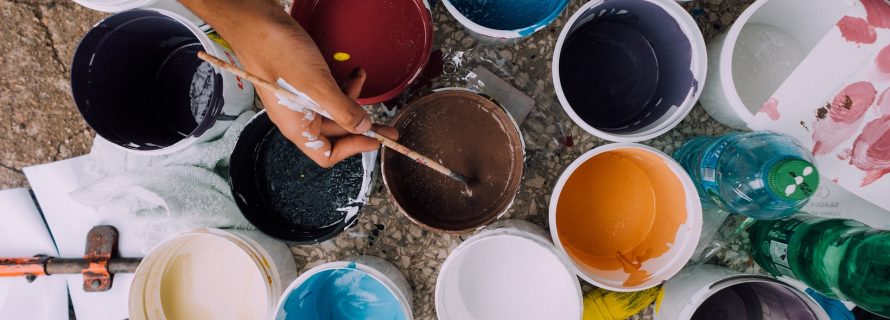Painting techniques you should know for your home renovation

Are you interested in renovating your home? Do you want to give your walls a nice, fresh coat of paint but you are not sure which technique would be best? If your answer to either one of these two questions is yes, you should definitely keep on reading this article. In the following paragraphs, we will present some of the easiest, yet effective and aesthetically-pleasing painting techniques.
Before we proceed with the actual techniques, keep in mind that painting is one of the major steps involved in the home renovation process. It is important to get it right, as it can make your home look brand new. Each painting technique creates its own effect, so you need to think long and hard about what you want. And, remember, painting is indeed one of the cost-advantageous solutions for changing the appearance of your home.
#1 Stenciling
If you have decided to paint your home, stenciling is a technique definitely worth trying. You can give it a try, whether you have artistic skills or not, and it will most likely spice up the interior of your house. Stencils come in any size and design, so variety is ensured.
All you have to do is tape the chosen stencil on the wall, using your preferred paint color to fill in the open sections. As this technique is meant to bring out the room décor, it is often recommended for nurseries or children’s rooms. Of course, you can use it for any other room in the house.
#2 Color washing
For those you who are going for a unique texture, color washing might be a suitable technique. You can begin by applying a base coat of paint, in the desired color. Next, apply a second coat of paint, but in a lighter color (this should be mixed with glaze).
The lighter second coat will allow the base coat to be visible, this being known as a translucent effect. The glaze has the purpose of softening the final appearance. The second layer should be applied only after the base coat has dried and best diagonally, so to cover previous strokes.
#3 Combing
The use of a combing tool allows for the creation of a striated effect. You can resort to this technique to create vertical lines, which resemble the fabric of silk, or other patterns, such as waves or horizontal stripes. The combination between paint and glaze is beautiful, to say the least.
Begin by applying the base coat of the desired color. Next, apply the glaze, also in the color you want. It is now time to use the combing tool to create the combing effect. Provided the technique is done well, the base coat will appear throughout the glaze.

#4 Ragging
One of the easiest painting techniques to master, ragging can change a room completely. The final texture is rather soft, reminding one of actual fabric; the multicolored appearance adds to its elegant effect. This technique can be used to hide a wall with damage, but also in parts of the house where there is a lot of activity, such as the kitchen.
You can begin by mixing glaze with different colors. Next, take a cotton rag and soak it in the resulting mixture. After removing excess paint, apply the rag on the wall and create the pattern you desire. You will probably notice that ragging resembles sponging as a technique, but the texture will be more intense (compared to using a sponge).
#5 Sponging
Sponging, as mentioned above, shares common characteristics with ragging. It is used to create decorations on the walls, being simple to master, even by complete beginners. The technique allows one to hide a damaged wall and it is just as suited for heavy-traffic parts of the house, such as the hallway or the bathroom.
Begin by applying a generous base coat. Next, take a sea sponge and apply the glaze in a different color. The one thing to make sure is that the sponge is a little bit damp before dipping it in the glaze. Added colors can highlight the wall texture even more. Depending on the colors used, you can either give depth to your walls or obtain a more obvious intensity.
In conclusion, these are some of the most effective and easy-to-master painting techniques. In accordance to the size of your home, you can give all of these a try and decide on which one you like the most. Happy painting and enjoy the new look of your home!
About the author: Wendy Wishart can’t even remember a time when she wasn’t writing and editing in some capacity. She regularly writes for Paintersinbergencountynj.com. In fact, when she’s not writing, she’s working on her stand-up routine, which is getting her a lot of laughs at local comedy nights. She loves puppies, coffee and Netflix, and hates frozen pizza, cell phones, and cilantro.
Images by Free-Photos from Pixabay & Thanks for your Like • donations welcome from Pixabay
References: https://www.britannica.com/art/stenciling https://en.wikipedia.org/wiki/Color_wash https://homeguides.sfgate.com/combing-painting-technique-28797.html http://www.decorative-faux-painting.com/ragging.html https://www.familyhandyman.com/painting/techniques/how-to-sponge-paint-a-wall/
- Additions and New Construction
- All Exteriors
- Alterations
- Basements
- Bathrooms
- Customer Service
- Customer Stories
- Decks
- Design & Planning Show
- DIY
- Doors
- Educational Resources
- Extreme Makeover Home Edition
- Fashion Show
- General Remodeling
- Green Living
- Handyman Home Services
- Home Decor
- Home Entertainment
- Home Improvement
- Home Improvements
- How to Tips
- In The Community
- Kitchens
- Off-the-Wall Remodeling Stories
- Remodeling
- Resources
- Roofing
- Siding
- Social Media
- Sunrooms
- Tips & Tricks
- Trends
- Windows

